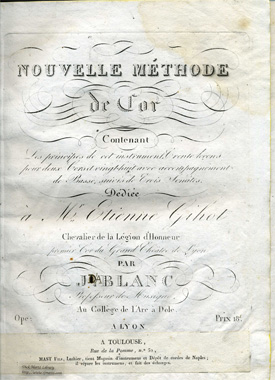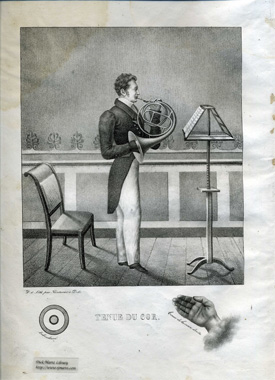Monsieur J. Blanc is undoubtedly the same
person as Jean Antoine Blanc born in Barcelona,
Spain, January 21, 1793 and died at Lons-le-Saunier,
Jura, France on December. 23, 1869.1 He is now best known for his
concert piece for organ La procession de la fête
d'un village surprise par un orage, op 14. In the
preface to the edition published by Delatour (2004),
Pierre Guillot writes:
This work of Lédonien.2
Jean-Antoine Blanc was first published in 1863 (and
probably never since) by Romary Grosjean in his famous
Journal des Organists. The great déodatien.3
publisher-organist published in the same journal a
"Grand chœur pour sortie" by the same author. This, it
seems, to all the musical works remaining of Jean
Blanc - where are the thirteen opuses preceding this Procession?
- should be add his opus 15, Méthode Spéciale pour
L’étude des Pédales de l'Orgue, published by the
Parisian publisher Richault in 1866, dedicated "to
François Benoist, professor of organ at the Paris
Conservatory, who kindly approves this work." But this
Méthode does not seem to be preserved, despite
the small reputation it earned its author through the
celebrated organist Montauban Jean-Baptiste Labat who
wrote its preface [1].
What remains of his reputation? Very little is known
about Jean Blanc, tenured organist for the Cordeliers
at Lons-le-Saunier (Jura) between 1837 and 1869, and
the author of this Procession posted here. He
was born in Barcelona, Spain, January 21, 1793. How
has did he arrive at the birthplace of Rouget
de Lisle? That is currently unknown. But he is
there in the 1830s both as an organist and as a music
teacher, a double position he held until his death at
Lons-le-Saunier, December 23, 1869. Married to Marie
Antoinette Majorai (born in Madrid and died in Lons
February 18, 1865), they will have at least one
daughter, Suzanne - later Mme. Louis Elisha
Jeaux - who was a music teacher like her father
and shared a time, but fully, his tenure of church of
the Cordeliers. Seemingly preoccupied with
developing playing with pedals in France, Jean Blanc
played an important role in changing the pedal organ
sound at Cordeliers in Lons le Saunier in 1842. On the
other hand and simultaneously, he attempted to
establish a factory in his city for pedals adaptable
to the upright piano.
[1] In his famous work L'orgue [...] (Nancy,
Vagner, 1850) abbot Régnier had already raised the
interest of Jean Blanc to the pedals of the organ.
In addition to the works cited above the following have
been identified by J. Blanc.4
Tyrolienne variée pour le cor, avec
accompagnement de quator, chez l'Auteur, Dôle
(Jura). [1827]
O Salutaris hostia, à trois voix, chez
veuve Févrot, Lyon. [1827]
Collection de musique militaire d'une exécution
facile et brillante, à l'usage des musiques des
sapeurs-pompiers, contenant marches, pas redoublés.
Ire et IIe livraisons,
Janet et Cotelle, r. Saint-Honoré, 123; Rousset, Lyon
r. Lanfond, 6. [1827]
Jeu des notes musicales: par J. Blanc,
organiste à Lons-le-Saulnier. In-8o d'une
demi-feuille. Imp. de Courbet, à Lons-le-Saulnier.
[1844]
Grande méthode complète et raisonnée pour le
violon, composée sur un plan nouveau, Grus,
boulevart Bonne-Nouvelle, 31. [1846]
Contredansier (le). Publication de musique de
bals, pour orchestre, composé par une société
d'artistes. 1re collection. No
1: Réves dorés, quadrille, par A. Couturier, -
No 2: L'Aurore d'un beau jour,
quadrille, par A. Lamotte. - No 3: Les
Souvenirs du bon vieux temps, quadrille, par H.
Vincent. - No 4: Mes premières armes,
quadrille, par Couturier. - No 5: Circé,
polka, par idem. - No 6: La
Saint-François, quadrille. - No 7: L'Artilleur,
quadrille. - No 8: Louisette,
polka, par J. Blanc., Ribemont (Aisne), M.
Couturier, éditeur. [1859]
On October 26, 1843, Le Salon Musical, published
by the Bureaux à Lyon, reported:
The excellent musicians of St. Nizier, led
by the skillful Mr. Blanc, will perform the following
pieces on All-Saints day, :
1° L'ouverture du Giuramento, by Mercadante
2° La Fête des Morts, andante funèbre, by
Blanc (unpublished)
3° Le Jugement dernier de Vogel,
arranged for musique militaire by Blanc
4° Marche Funèbre, by Mohr.
|


